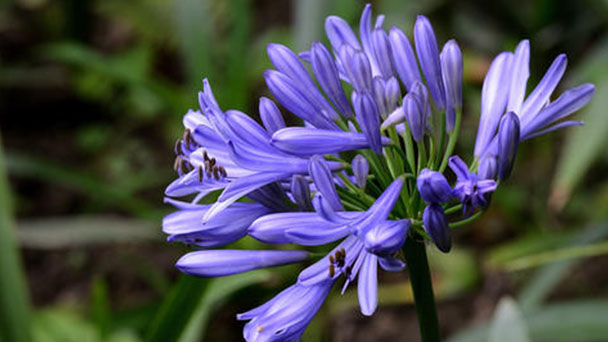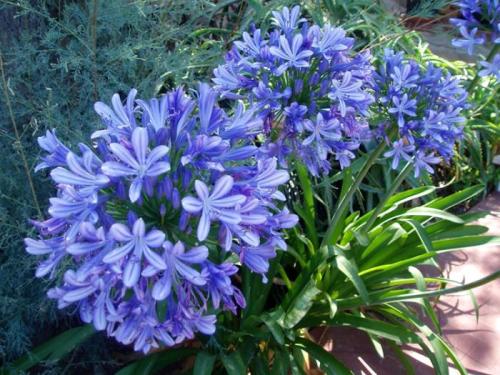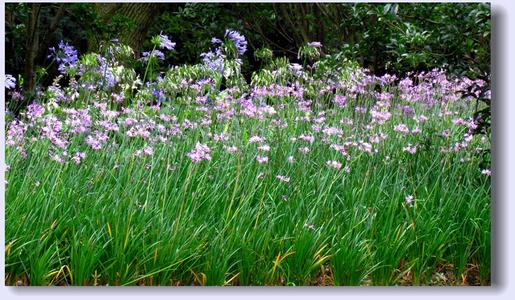African Lily (Agapanthus Africanus) Profile: Info, Care & Growing Guide
Written by Maggie
Nov 02 2021

African Lily (Agapanthus africanus), also called lily of the Nile, is a plant of the genus African Lily in the family Lycoris. Leaves are linear-lanceolate, subleathery; Flower stems are erect, up to 60 cm tall; Umbel, with 10 to 50 funnel-shaped flowers, dark blue or white, anthers first yellow, then black; African Lily likes warm, moist and full of sunshine. The relatively dormant winter basin soil should be kept slightly dry; The overwintering temperature should not be lower than 8℃. The north needs greenhouses for winter.
African Lily Picture

Characteristics of African Lily
African Lily is a perennial herb. Leaves are linear-lanceolate, subleathery; Flower stems are erect, up to 60 cm tall; Umbel, with 10 to 50 funnel-shaped, dark blue or white flowers, anthers first yellow, then black. African Lily has dark green and bright leaves, blue and purple flowers, but also white, purple, large flowers and variegated leaves.
African Lily Growing Conditions
African Lily prefers warm, moist and sunny environments. It is required to be cool in summer and warm in winter. If the winter soil moisture is high and the temperature exceeds 25℃, the stem and leaves will grow vigorously and hinder dormancy, which will directly affect the normal flowering of the next year.
Light also has a certain effect on growth and flowering. Avoid long direct exposure to strong light in summer. Cultivation in winter needs sufficient sunlight. The soil should be loose and fertile sandy loam with a pH of 5.5 ~ 6.5. Water accumulation should be avoided.
How to Care for African Lily
African Lily Soil Care
African Lily needs loose soil, so the soil will be loose and fertile sandy loam with a pH of 5.5 ~ 6.5. Generally, the basin soil can be mixed with 2 parts of decayed manure soil, 6 parts of leaf rot soil and 2 parts of sandy soil.
African Lily Light Requirements
African Lily is a flower plant that likes light. It can get a moderate amount of direct sunlight, but not too long of direct sunlight. When curing African Lily, flower friends are advised to place african lily in front of a window sill with bright light, good ventilation and no direct glare. In addition, strong light should be avoided for a long time in summer, and sufficient sunlight should be needed for winter cultivation.
African Lily Watering
Water the African Lily at the level of moisture, dry as wet as wet. It is especially important in summer, so you must water it with sufficient water, and you can spray water around the African Lily plant to increase humidity and cool down. Winter should pay attention to control watering, keep the basin soil slightly wet, and can not be watered more.
African Lily Temperature Care
African Lily likes warmth and is not cold tolerant.It is generally cool in summer and warm in winter. If the winter soil moisture is high and the temperature exceeds 25℃, the stem and leaves will grow vigorously and hinder dormancy, which will directly affect the normal flowering of the next year.
African Lily Fertilizer
African Lily is a flower plant that prefers fertilizer. Generally, application of topdressing should be started when the leaves of African Lily grow to 5-6 cm long. In general, application of decaying cake fertilizer should be applied once every half a month, and once every 20 days after flowering.
The day before fertilizing African Lily, water should be stopped once to collect water from the basin soil. After fertilizing, the leaves should be sprayed with clear water. It is better to alternately use manure, cake fertilizer and chemical compound fertilizer, once every 10-15 days.
In order to make the seedling blossom early, African Lily should be given sufficient fertilizer and water.
How to Propagate African Lily
African Lily is commonly used for propagation by dividing and seeding.
African Lily Propagation from Division
Separate the over-dense old plants, and 2-3 clusters per pot is appropriate. Flowering two years after dividing. If dividing in autumn, flowering can also occur in the following year.
African Lily Propagation from Seed
Sow, about 15 days after sowing germination, seedling growth is slow, needed to cultivate 4 to 5 years before flowering.

Disease Control of African Lily
African Lily Leaf spot
Common leaf spot harm, can use 70% methyl tobutine WP 1000 times liquid spray prevention and control.
African Lily Lupus disease
Leaves, pedicels, petals and bulb scales of African Lily can be affected by the disease.Leaves and pedicels infected, become curved or deformed, showing red raised spots; The petals and corm scales also show brown spots after infection and become soft and sunk in the late stage.The heavily damaged pedicels affect flowering. The pathogen is a kind of fungus, and can also harm the bulb flower stem such as daffodil, Manjusri orchid.
To prevent and cure this disease, when watering to prevent water drops in the leaf. Come on when gush 1 time 600 times hundred bacterium clear water fluid, the effect is better.
Distribution of African Lily
African Lily is originally from South Africa and is widely cultivated throughout China.
African Lily Uses
African Lily flowers in summer, beautiful flowers, suitable for potted indoor ornamental, in the south of the semi-shady cultivation, as a rock garden and flower path ornament plant.

Latest Updated
- Benefits of Bugleweed - 7 Science-backed Health Benefits
- Bugleweed Dangers & Side Effects - Is It Poisonous?
- How to Plant Evergreen Trees - What You Should Know
- When to Plant Evergreens - Grow Guide for Evergreen Trees
- 12 Wonderful Evergreen Shrubs for Your Garden
- 12 Popular Evergreen Plants with Pictures for Beginners
- When And How To Prune A Lilac Bush Like a Pro
- How to Grow & Care for Lilac Vine (Hardenbergia Violacea)
- Japanese Lilac Tree (Syringa Reticulata) Care & Propagation Guide
- Shumard Oak Pros and Cons - What to Know
Popular Articles
- Winter maintenance of Antirrhinum Majus
- How to Grow Terminalia Mantaly Tree
- How to Grow and Care for Crossostephium Chinense
- How to grow Antirrhinum Majus in spring
- Peristeria Elata (Dove Orchid) Profile: Info & Care Guide
- Underwatered Snake Plant (Sansevieria Trifasciata) - Signs And How To Fix
- How to Care for Brazilian Jasmine Plant (Mandevilla Sanderi)
- How to Grow & Care for Graptopetalum Purple Delight in Summer
- Rosa Chinensis (China Rose): Plant Growing & Care Tips
- How to Care for Baby Sun Rose (Aptenia Cordifolia)